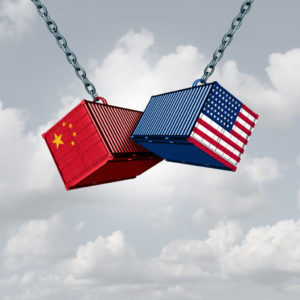News & Insights
Phase 1 of a Comprehensive Economic and Trade Agreement Signed with China, Certain Section 301 Tariffs on Chinese Origin Goods to Be Lowered on February 14th
On January 15, 2020, the United States and China signed Phase 1 of a comprehensive Economic and Trade Agreement, which is intended to address a wide array of issues that are at the heart of the ongoing trade dispute between the two countries. The Phase 1 Agreement is slated to officially enter into force on February 14, 2020. The Agreement has been described as a “historic and enforceable agreement” by the Office of the U.S. Trade Representative (“USTR”) which will require structural reforms to China’s economy and trade regime, consists of a commitment by China to make substantial additional purchases of U.S. goods and services, and contains a strong dispute resolution mechanism.
As a result, the United States has agreed to lower the current Section 301 tariffs on imports of certain Chinese-origin goods. On January 22, 2020, the USTR published a Notice of Modification of Action in the Federal Register (85 Federal Register 3741) announcing that the Section 301 tariffs imposed on the List 4A goods from China will be reduced from 15% to 7.5% on February 14, 2020 (the date on which the Phase 1 Agreement formally enters into force). President Trump also recently stated that ALL of the Section 301 tariffs may be eliminated if a Phase 2 Agreement with China is reached.
The following table summarizes some of the key commitments made in the Phase 1 Agreement—
| Prohibitions on Trade Secret Theft |
China has agreed to— · Expand the scope of civil liability for trade secret misappropriation to any natural or legal persons involved in those illegal activities, including individual former employees or cyberhackers. · Extend the prohibitions on trade secret theft to electronic intrusions, breaches of confidentiality, and the inducement of a breach of confidentiality. · Shift the burden of proof in civil cases to the defendants when there is a reasonable indication of trade secret theft. · Grant preliminary injunctions for trade secret owners to prevent the use of their stolen trade secrets before the trade secrets have lost their value. · Allow for the initiation of criminal investigations for trade secret theft without the need to show actual losses, which are difficult to prove before the trade secret has lost its value. · Ensure that criminal enforcement is available for willful trade secret misappropriation, including acts of theft, fraud, physical or electronic intrusion for an unlawful purpose and the unauthorized or improper use of a computer system. · Prohibit the unauthorized disclosure of such information by government personnel or third-party experts or advisors. |
| Patents and Pharmaceutical-Related IP |
China has agreed to— · Establish a mechanism for the early resolution of pharmaceutical patent disputes, including a cause of action to allow a patent holder to seek expeditious remedies before the marketing of an allegedly infringing product so that innovative pharmaceutical companies can effectively enforce their rights in China. · Provide patent term extensions to compensate for unreasonable patent office and marketing approval delays that cut into the effective patent term. · Permit the use of supplemental data to meet relevant patentability criteria for pharmaceutical patent applications. |
| Trademarks and Geographical Indications (“GI’s”) |
China has agreed to— · Invalidate or refuse bad faith trademark applications. · Ensure that any GI measures taken in connection with an international agreement do not undermine market access for U.S. exports to China using trademarks and generic terms. · Use relevant factors when making determinations for “genericness,” including usage of a term in dictionaries, newspapers, and websites, how the good referred to by a term is marketed and used in trade, and whether the term is used in relevant standards. · Not provide GI protection to individual components of multi-component terms if the individual component is generic, and to publicly identify which individual components are not protected when granting GI protection to multi-component terms. |
| Enforcement against Pirated and Counterfeit Goods |
China has agreed to— · Provide effective and expeditious action against infringement in the online environment, including requiring expeditious takedowns and ensuring the validity of notices and counternotices. · Take effective action against e-commerce platforms that fail to take necessary measures against infringement. · Take effective enforcement action against counterfeit pharmaceuticals and related products, including active pharmaceutical ingredients. · Significantly increase actions to stop the manufacture and distribution of counterfeits with significant health or safety risks. · Provide that its judicial authorities shall order the forfeiture and destruction of pirated and counterfeit goods, as well as the materials and implements predominantly used in their manufacture. · Significantly increase the number of enforcement actions against pirated and counterfeit goods at physical markets in China and that are exported or in transit. · Ensure, including through third party audits, that government agencies and SOEs only use licensed software. |
| Deterrent-Level Remedies and Penalties and Issues in the Judicial System |
China has agreed to— · Impose civil remedies and criminal penalties for IP theft, including increasing the range of minimum and maximum pre-established damages, sentences of imprisonment, and monetary fines. · Transfer cases from administrative authorities to criminal authorities when there is a reasonable suspicion of a criminal violation. · Expeditiously enforce judgments for violations of intellectual property rights. · Provide legal presumptions of copyright ownership and waiving certain other requirements for bringing copyright infringement claims. · Eliminate or streamline requirements for foreign litigants to authenticate evidence for use in Chinese courts. · Provide a reasonable opportunity to present witnesses and to cross-examine opposing witnesses in civil proceedings. |
| Forced Technology Transfers |
Both the United States and China have agreed to— · Prohibit the forcing or pressuring of foreign companies to transfer their technology as a condition for market access, administrative approvals, or receipt of any advantages. · Require that any transfer or licensing of technology be based on market terms that are voluntary and reflect mutual agreement. · Prohibit state-directed or supported outbound investment aimed at acquiring foreign technology in sectors and industries targeted by a party’s industrial policies. · Conduct enforcement and administrative proceedings that are impartial, fair, transparent, and non-discriminatory. |
| Agricultural and Seafood Products |
· China will purchase and import at least $40 billion of U.S. food, agricultural, and seafood products annually for a total of at least $80 billion over the next two years, and will strive to import an additional $5 billion per year over the next two years. · China will implement a transparent, predictable, efficient, science- and risk-based regulatory process for the evaluation and authorization of products of agricultural biotechnology—China’s timeframe for review and authorization for 2 products for feed or further processing will be an average of 24 months. China has also agreed to certain administrative improvements in the application process and to certain steps to address situations of low-level presence. · China will abide by its current World Trade Organization (WTO) obligations on the transparency of its domestic support measures, and will comply with its WTO obligations for its administration of wheat, corn, and rice tariff-rate quotas (TRQs) including the allocation methodology, treatment of non-state trading quota applicants, and transparency. · With respect to sanitary and phytosanitary (“SPS”) standards, China will abide by established timeframes for regulatory actions for meat, poultry, seafood, dairy, infant formula, rice, potatoes, nectarines, blueberries, avocadoes, barley, alfalfa pellets, hay, feed additives, distillers’ dried grains (DDGs), distillers’ dried grains with solubles (DDGS), and pet food, and will refrain from implementing food safety regulations that are not science- and risk-based and shall only apply such regulations to the extent necessary to protect human life or health. · China will implement, by February 2020, FSIS’ Public Health Information System, which is an electronic and automated system for foreign countries to access FSIS meat and poultry export certificates. China will also ensure that relevant certificate information is shared in a timely manner to the Chinese port customs officials to prevent undo delay for clearing such shipments at the port of entry. China also will accept replacement certificates issued by FSIS for situations consistent with Codex guidelines. · China will streamline the timelines and procedures for registering U.S. facilities and products and to provide regulatory certainty and market stability for products like fluid milk and dairy permeate powder. · China will authorize the importation of U.S. rice from any rice facility approved by USDA’s Animal and Plant Health Inspection Service (APHIS) within 20 business days of China’s receipt of a notification from the United States that APHIS has approved the facility as compliant with the phytosanitary protocol agreed to by the United States and China. · China will allow U.S. medium grain rice to be imported under the tariff rate quota for “Rice, short and medium grain” allowing U.S. rice to compete with comparable rice grades in the Chinese market. · China agreed to allow the import of 26 previously unapproved aquatic species through a side letter that accompanies the Agreement, and committed to streamline the timelines and procedures for registering U.S. seafood facilities and products, including fish meal and oil, by updating its facility registrations within 20 business days of receipt of a list from FDA and the National Oceanic and Atmospheric Administration (NOAA). · China has agreed to immediately resume imports of pet food containing poultry ingredients and to lift the ban on ruminant ingredients, allow imported animal origin ingredients in pet food, and limit the Polymerase Chain Reaction (PCR) testing to pet food with non-ruminant ingredients (which is to be done on a risk-based selection of shipments). China also agreed to streamline the facility registration process, by eliminating the requirement for facility questionnaires, and to immediately register 24 facilities that had been waiting to be listed on GACC’s website. · China has agreed to ensure that it administers its TRQ for corn, wheat, and rice with specific obligations to: (a) allocate the full TRQ by January of each year; (b) not discriminate between state trading enterprises and non-state trading enterprises; (c) reallocate unused or returned TRQ amounts; (d) ensure that allocations are made in commercially viable shipping amounts; (e) enhance transparency of the eligibility criteria and allocation principles; (f) ensure there is a sufficient number of state trading enterprises and non-state trading enterprises eligible to receive allocations and that full utilization of the TRQs is not inhibited; (g) provide relevant allocation and reallocation information upon request of the United States; and, (h) make public on a website existing laws, regulations and announcements on the administration of the TRQs. |
| Financial Services |
· By April 1, 2020, China will eliminate the foreign equity cap for securities companies, U.S. suppliers of insurance (i.e., life, health and pension insurance), fund management companies, and future companies. China will also ensure that (a) U.S. suppliers are able to access China’s market on a non-discriminatory basis, including in regard to review and approval of qualified license applications; and, (b) its regulatory authorities operate an improved and timely licensing process for U.S. suppliers of electronic payment services so as to facilitate their access to China’s market. · China will also expand opportunities for U.S. financial institutions, including bank branches, to supply securities investment fund custody services by taking into account their global assets when they seek licenses, as well as take into account the international qualifications of U.S firms when evaluating license applications for Type-A lead underwriting services for corporate bonds in China’s bond market, which is the third largest corporate bond market in the world. · China will also remove barriers facing U.S. suppliers of credit rating services, including approving applications by wholly U.S.-owned suppliers (allowing them to rate all types of domestic bonds sold to domestic and international investors), as well as allow U.S. companies to acquire a majority stake in their existing joint ventures with Chinese companies. |
| Expanding Trade |
China has committed that, over the next two years, it will import no less than $200 billion of U.S. goods and services on top of the amounts that it imported in 2017 in the following categories: · U.S. manufactured goods (e.g., industrial machinery, electrical equipment, pharmaceutical products, aircraft, vehicles, optical and medical instruments, iron and steel, solar-grade polysilicon, hardwood lumber, and chemical products, among other goods) totaling at least $120.0 billion in 2020 and at least $131.9 billion in 2021; · U.S. agricultural products (e.g., soybeans, cotton, grains, meats, ethanol, seafood, and the full range of other agricultural products) totaling at least $80 billion over the next two years with purchases of an additional $5 billion of agricultural products annually; · U.S. energy products (e.g., liquefied natural gas, crude oil, and metallurgical coal) totaling at least $30.1 billion in 2020 and at least $45.5 billion in 2021; and, · U.S. services (e.g., financial services, insurance services, cloud services, and travel services) totaling at least $99.9 billion in 2020 and at least $112.2 billion in 2021.
|
Miller Proctor Law PLLC will continue to track the entry into force of the Phase 1 Agreement with China, new developments in the Section 301 tariffs imposed against China, as well as the negotiation of Phase 2 of the comprehensive agreement with China. If you have any questions relating to these issues, please contact Melissa Proctor (melissa@millerproctorlaw.com) at Miller Proctor Law PLLC (https://millerproctorlaw.com ).
News & Insights

U.S. Announces Withdrawal from the Iran Nuclear Deal and the Snap-Back of Previously Lifted Sanctions
On May 8, 2018, the President announced that the United States would withdraw from the Joint Comprehensive Plan of Action (“JCPOA”), and begin reimposing the nuclear-related sanctions that were lifted in 2015. He also issued a National Security Presidential Memorandum

ITAR Interim Final Rule on Encryption Became Effective on March 25th
On March 25, 2020, the following Directorate of Defense Trade Controls’ (DDTC’s) Interim Final Rule, commonly referred to as the “Encryption Rule” took effect. See 84 Federal Register 70887 (International Traffic in Arms Regulations: Creation of Definition of Activities That


